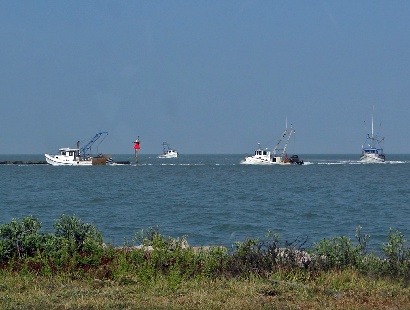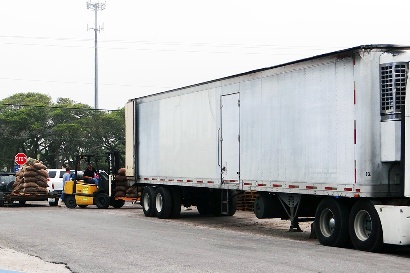|
In
April 1947 Reagan High School students were shocked out of their seats
when the Vancamp a ship loaded with fertilizer exploded at Texas
City. We all went to the open windows of our classes at this Houston
(Heights area) school to see what happened. At 43 miles away if we
saw anything it was only some smoke. The blast started us talking
about boating in Galveston Bay.
That was 6 years before the Lake Houston Dam was completed and 10
years before this first lake in the Houston
area became useable. That is why we chose the bay. None of us thought
about the distance of 16 miles as the crow flies across the bay to
Smith Point.
When that summer day arrived Bob McGee, Don Daily, John Artz, Robert
Below, Ernest Albers and myself left for Seabrook
on Galveston Bay to rent a boat. Each of us was 2 years from graduating
as part of Houston’s first
class of 12 years of public schooling. But none of realized this first
seafaring trip could be our last – except for a confluence of good
luck.
John had brought his 16hp Scott Atwater motor along which he attached
to our rented boat. We headed straight out across Galveston Bay. The
further we went the choppier the water got. Finally the bow started
taking on water so we made a U-turn even though we feared the transom
might take in more water. Headed back toward the shore looked good
but that was a mistake too because the choppy water sunk the boat
quickly.
In desperation John shut off his motor and started un-clamping it
as Bob stepped up to help in lifting it. Speechless all of us began
to just stand up - as the boat went down. At about our waist height,
the water stopped rising. Now hundreds of yards out in the bay we
wondered why the boat stopped sinking. Finally we stepped out of the
boat and found we were standing on the bottom.
Our feet were tough, but the bottom was uncomfortable. We were on
a bed of oysters. Maybe 50 yards away was a small island of old shells
and nearby a homemade inboard boat was tied to a pole. Some of us
swam over there. Luckily the boat key was in the ignition. We started
it, and towed our boat back to the store where we rented our boat.
We gave them both boats - and our story. The fact that oysters kept
us from drowning is what I like most about oysters. |
 |
Boats Returning
Photo courtesy Ken
Rudine, April 2013 |
Oysters Packaged
Photo courtesy Ken
Rudine, April 2013 |
Boat Unloading
Photo courtesy Ken
Rudine, April 2013 |
Local
Hauling
Photo courtesy Ken
Rudine, April 2013 |
Ready
For Loading
Photo courtesy Ken
Rudine, April 2013 |
Oysters are a
bi-valve (two shells) mollusk that live in brackish water. Brackish
water is any mixture of seawater and run-off from the surrounding
land mass. That is a description of most bays.
Back then I only knew what my Daddy told me about oysters. What he
said was oysters are only edible in months spelled with “R”. That
would be September through April. With the advent of refrigeration,
some rules have changed. Oysters lay millions of eggs in the warm
water, so harvesting stops then. It is estimated only 1 egg in 4 million
might reach maturity.
I have heard many stories about eating oysters but I don’t intend
to add to the confusion. My mission is to fill in information by way
of photos about how you are furnished the opportunity to eat oysters.
Most oysters are dredged up, culled and sacked before the boats reach
their harbor. I have seen some boats returning with such heavy catches
there are only inches of their draft out of the water. At the dock
I watched one boat unload 40 sacks, which is equal to 4,000 pounds
placed on pallets for forklift loading. I saw a fully loaded, over
the road, refrigerated van leave from Fulton
TX headed to Florida. |
 |
Refrigerated
Van
Photo courtesy Ken
Rudine, April 2013 |
Oyster Shells
Photo courtesy Ken
Rudine, April 2013 |
|
One large oyster
averages filtering a barrel of water for plankton during a typical
day. For food, they are shipped in the shell alive on ice or refrigerated.
The shells can be pulverized for chicken feed and fertilizer or
burned to make quicklime. Quicklime is calcium oxide, a caustic
alkaline substance used for mortar, flux, treating corn and to waterproof
boats.
The packaging standard is twenty burlap sacks of oysters placed
on a pallet for handling and loading. Texas oysters are a nourishing
shellfish. They should not be confused with pearl oysters, which
are from a different genus. There are about a hundred species of
oysters. The edible kind never produces pearls.
Recently I learned there is one other species of oysters AKA, PRAIRIE
OYSTERS. And they are award winning from Canada. Look them up, listen
and enjoy.
© Ken
Rudine, May
6, 2013 Column
More Traveling
Team Rudine
|
|
|
